The world's most expensive mushroom truffle
Mushroom truffle is one of the rarest and most expensive in the world. It grows underground, at the roots of oak, beech, hazel. It is collected according to special, characteristic signs or with the help of animals. The mushroom is included in the most refined dishes, has an unusual taste and aroma. It began to be cultivated the century before last, but since the harvests are small, the prices remain high.
- Description of the mushroom
- Where truffles grow
- Types of truffles
- Piedmont truffle
- Black Perigord truffle
- Black winter truffle
- Black summer truffle
- Black autumn truffle
- Oregon White Truffle
- Himalayan truffle, or Chinese
- African truffle
- Red glitter truffle
- Red truffle
- White March truffle
- Truffle-like species
- How truffles are harvested
- Growing truffles at home
- Growing technology
- Conclusion
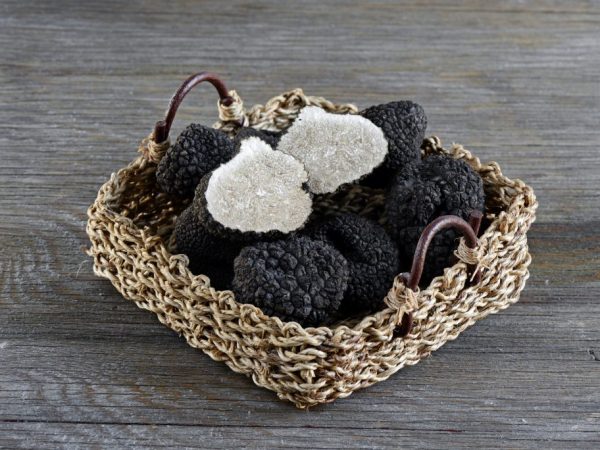
The world's most expensive mushroom truffle
Description of the mushroom
Truffle is a mushroom from the department Actinomycetes (crimson) and the order Pececia, of the Truffle family of the Truffle genus. The fruit bodies of these amazing mushrooms are almost completely hidden underground, in their "appearance" they resemble cones or tubers of potatoes. No wonder in Latin the name sounds like "terrae tuber", or "earthen cone".
From above, the fungus covers peridium - the outer casing layer with numerous warts or cracks. In some species, it is almost white. The inner flesh is marble-like when cut. It consists of internal and external veins, which have different shades. In the internal veins, sacs of spores mature. They are lighter than the outer ones. The color of the pulp varies from species to species.
According to the species description, the aroma of the truffle mushroom has several notes: the smell of an autumn forest, rotten foliage, humus, ripe fruits, even cocoa and chocolate. The truffle tastes like a nut or roasted seeds, sometimes it has a fruity, coconut or chocolate aftertaste. It is prepared with minimal heat treatment; gourmets advise eating it raw so as not to lose its unique aroma and flavor. If you send a truffle for storage, it loses most of its qualities.
The mushroom is used as a seasoning for various dishes. It goes well with poultry, steaks, pasta, omelet. It is used to make sauces, gourmet pates, fillings. Its calorie content is low. The beneficial properties of mushrooms are also known. They contain vitamins of group B (B1, B2), PP, C and essential amino acids. Once these mushrooms were used as an aphrodisiac.
Truffle mushroom cannot be stored for a long time: only 2-3 days in a refrigerator at a temperature of + 1 ... + 2 ° С in a glass jar or a tightly closed container. Fresh mushrooms are bought during the harvest season. At the same time, restaurants serve a special “truffle menu”. Mushrooms are canned in cognac, wine, sometimes they make special oil, paste. But the taste of these products is completely different.
Where truffles grow
Truffle mushrooms grow in forests of deciduous, rarely mixed trees. Their mycelium settles on the roots, taking away all the necessary nutrients from them. Of particular value are fruit bodies that have grown at the roots of an oak, less valuable settle near beech, birch, hazel, linden, poplar.Groups of 3-7 are found near one tree, but often they grow alone. Fruit bodies lie at a depth of 5 cm to 30 cm (on average - 20 cm).
Irina Selyutina (Biologist):
Indeed, truffle mycelium can give rise to 3-7 fruiting bodies, which are usually arranged in a circle, forming a nest. Fruit bodies here will be of different sizes.
When these valuable mushrooms ripen, the soil rises above them, which for the truffle collector serves as a clear indicator of the presence of fruiting bodies in a given place. Every year there is a gradual growth and expansion of nests. With skillful collection, i.e. preserving the integrity of the mycelium, in these places - truffles, you can harvest in subsequent years.
It takes 3-4 months for a truffle to fully develop.
The habitat of the species is Western and Central Europe, the European part of Russia, the Caucasus, Crimea, the Mediterranean. A specific white Moroccan truffle grows in North Africa. Its mycelium settles on the roots of coniferous trees - cedar, pine, although it can also envelop the root system of an oak.
Types of truffles
There are different types of truffles. About a dozen are considered edible, but in total there are more than a hundred of them. Moreover, a number of inedible and poisonous species are referred to as other genera. They are related to a real truffle by their way of life: they also grow underground.
Piedmont truffle
The Piedmont truffle, or Italian white truffle, is the highest value in this family. It grows only in certain areas of Piedmont, in northern Italy. It is found in the hilly area around Turin, in Monferrato, Langhe and Roerot. It grows under oaks, willows, poplars, less often under lindens. The growing season is from mid-October to mid-February.
Characteristic:
- The fruiting body is tuber-shaped, with numerous outgrowths and deformations.
- The outer shell is yellow-red or yellow-brown, velvety, tightly attached to the pulp.
- The inner flesh is light (white or creamy), rarely has a slight pink tint or a marbled pattern.
- The size of the fruiting body is 2-12 cm.
- Average weight - 300 g, some specimens can reach up to 1-1.3 kg.
- The aroma is similar to cheese with garlic, with pronounced musky and earthy notes.
Sometimes this type is called the "golden Tuscan truffle", its price is the same as that of a gold bar of the same weight. Mushrooms are sold at special truffle auctions, which have been held since 1930. Fresh white truffles can be tasted in October-January, the most delicious specimens are harvested in November and December. At other times of the year, there are only canned ones, they taste much worse.
The cost of a white truffle is high, on average 3000-4000 € per 1 kg, sometimes more expensive. The most expensive and largest specimen, weighing 1.5 kg, was sold for $ 330,000 apiece. Piedmont truffles are sold at auctions one at a time. The product is wrapped in paper napkins and displayed from smallest to largest.
Each mushroom has its own pedigree, which indicates the time of collection, the tree under which it was found, the name and breed of the dog. Market traders do the same.
Black Perigord truffle
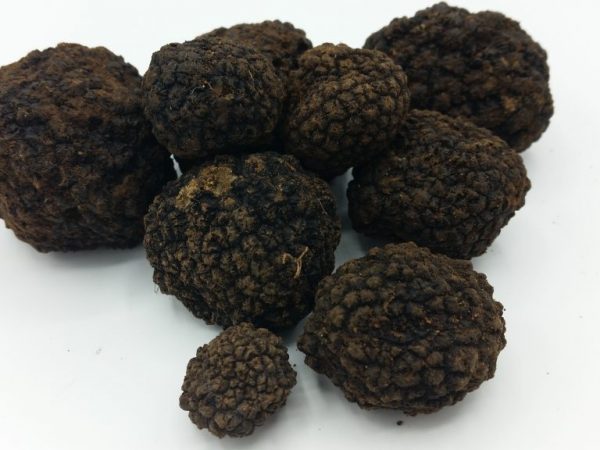
Truffles are recommended to be harvested in January
The Perigord or French black truffle is the second most valuable after the white one. It is widespread in France (the most fruitful places are located in the south-west of the country), in Spain, and Central Italy. This species has now begun to be grown artificially, it was brought to America, Australia, South Africa. Truffle mycelium thrives under an oak tree, less often under other deciduous trees. Mushrooms ripen from November to March. The best time to harvest this winter truffle is January and February.
Description of the mushroom:
- The shape of the fruiting body is rounded or slightly elongated.
- The upper layer (peridium) is brownish-red, turns black with age, covered with tetrahedral or hexagonal warts.
- The pulp is at first gray or red-brown, then turns into black-purple, the marble pattern is clearly visible on the cut.
- The size is about 9 cm in diameter.
- Average weight - 400 g.
- The aroma is nutty, with faint notes of nutmeg and chocolate, the taste is spicy, with bitterness.
The fungus of this species is aggressive, it destroys competitive plants, therefore it is easier to find the fungus underground than others. This can be done along the islets of bare ground in those places where the truffles are located. It used to be widely cultivated in France, now the yields there have declined, but it began to be grown in China, Australia and other countries.
Black winter truffle
Black winter truffle grows in France, Italy, Switzerland, Ukraine. Prefers moist soils. The mushroom loves linden and hazel roots, this variety is also found under birches and beeches. The main signs are:
- The shape is round, sometimes irregularly spherical.
- The upper skin (peridium) changes color with age from red-brown to black, covered with small warts.
- Young flesh is white, then takes on a black-purple tone with brown and yellow veins.
- Diameter - 8-12 cm.
- The weight is sometimes 1-1.5 kg.
- The smell is rich, musky.
This variety is harvested from November to February.
Black summer truffle
Russian truffle is the second name of the black summer truffle, found in Scandinavia, Central Europe, and also in Russia. It grows under oak, beech, hornbeam, rarely under birch or pine trees. The Russian truffle ripens from late July to early November.
Main characteristics:
- Round shape of the fruiting body.
- The outer layer is blue-black, warty.
- The pulp is at first dense, then becomes loose, streaked with veins.
- The color of this truffle ranges from white-yellow to brown-gray.
- Diameter - 2.5-10 cm.
- The average weight is about 400 g.
- On the palate there is a pronounced nutty shade with a taste of algae.
The peculiarity of this species is shallow burial under the ground, sometimes fruiting bodies even come to the surface. These are the only black truffles in Russia.
Black autumn truffle
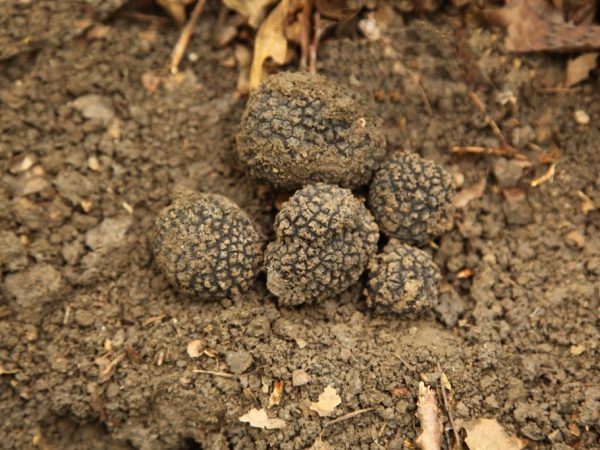
The mushroom tastes like hazelnuts
Autumn truffle or Burgundy truffle - valued lower than its other French and Italian counterparts. It grows in northeastern France, sometimes in Italy, rarely in England.
What this mushroom looks like:
- The shape is correct, round.
- The outer shell is covered with black tubercles.
- The pulp is dense, brown, with pronounced white veins on the cut, never becomes loose.
- The taste and aroma are reminiscent of hazelnuts with pronounced chocolate notes.
Truffles of this variety are harvested from late July to November.
Oregon White Truffle
Finding these mushrooms is realistic only in the western part of the United States. They are small, only 2.5-5 cm in diameter, weighing about 250 g. Their feature is shallow bedding in the soil. Mushrooms are often found directly underneath the needles. Their taste is characterized by a pronounced herbal and fruity accent.
Himalayan truffle, or Chinese
The species was first found in India at the end of the nineteenth century before last, then it was found in the Himalayas. Chinese truffle varieties are now grown artificially and exported all over the world. Their prices are lower, because mushrooms are much inferior in taste to their French and Italian counterparts.
This type of truffle looks like a small bump or potato with a dark, uneven skin dotted with cracks. The middle is gray-brown, with beige or yellowish veins, tough, smells weak, and the taste is lean. It is considered a type of black winter truffle.
African truffle
The African truffle mushroom, or steppe, is found in the Mediterranean, North Africa, the Middle East, Azerbaijan and Turkmenistan. The mycorrhiza forms mycorrhiza not with trees, but with herbs: sun lights and cistus.
Mushroom characteristics:
- The shape is round and elongated.
- The cover is brown or brown-yellow, smooth.
- The pulp is mealy, loose, white with brown or yellow streaks.
- The diameter of the fruiting body is about 5 cm.
- Mushroom aroma.
This type of truffle is not considered too valuable. It is sought and eaten by the local inhabitants of the coastal regions of North Africa, and also collected in Italy and France.
Red glitter truffle
The red shiny truffle is found in all European countries, in deciduous and mixed forests. Mycelium enters into symbiosis with both deciduous and coniferous trees. Collection time is from May to August. The sizes are small, 1-5 cm, weight - up to 50 g. The surface is brown-yellow, flesh with a pink tint, soft. The taste and aroma have hints of red wine, pear and coconut.
This species is considered a relative of the red truffle.
Red truffle
Red truffle is a common European species that is characterized by a red tint on the top layer. The flesh is yellow-brown with a typical marbled pattern. The sizes are small, weight - up to 80 g. The taste is sweetish, "meaty", with a grassy coconut tinge.
The red truffle has a low culinary value.
White March truffle
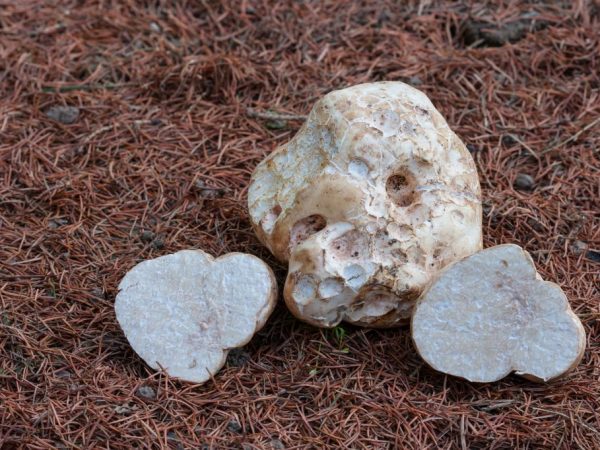
Young mushrooms are suitable for consumption
White March truffle grows in the south of Europe, including the Crimean region. The surface is light brown in youth, darkens over time to a reddish brown hue. The pulp is dense, with a pronounced mushroom aroma and garlic notes in young specimens. In old mushrooms, the smell becomes unpleasant, repulsive.
Fruit bodies are found under deciduous and coniferous trees; they ripen from December to April. The species lends itself to cultivation, but its cost is low.
There are several other types of edible truffles that are not of commercial interest: Duran, variegated, pubescent, ocher. The variegated white truffle is used to make oil; it is not eaten.
Truffle-like species
There are several types of mushrooms that do not represent the Truffle genus, but outwardly are very similar to them. Among them there are edible, conditionally edible and even poisonous.
Like real truffles, they grow underground and have rounded fruiting bodies. The mycelium parasitizes the roots of deciduous or coniferous trees. Here are some representatives:
- Melangaster Bruma, or false truffle: on the territory of Russia it is found in the Novosibirsk region, it is a rare species. Its fruiting body is round and smooth. The upper cover is yellow-brown, then darkens. The inner part is brownish, with rare light veins. Size - 2-8 cm. It has a pleasant fruity aroma, but the mushroom is inedible. It is found shallow under the forest floor.
- Rizopogon ordinary: it has a rounded shape, smooth surface. The color of the upper layer (peridium) is yellow-brown or orange, velvety. The pulp is firm, first white, creamy, then brown. The cut does not have the typical marble pattern. Smells faint, considered edible.
- White Polish, or Trinity Truffle: grows in Central Europe and Russia. It is found directly under the surface of the soil along the typical bumps. The diameter of the rounded tuber is 5-15 cm, the weight is 200-500 g. The outer shell is yellow-brown, felt. The pulp is mealy, light yellow, with characteristic veins. White truffles are harvested from late July to early November. They taste like meat, although they are inferior in quality to real truffles.
- Reindeer truffle: grows in spruce or mixed forests, mycelium is combined with spruce. The shape is round, tuberous. The top layer is smooth, golden or ocher colored. The pulp is at first white or creamy, then turns dark gray. The mushroom is inedible.
Most of these species are not specially harvested. They become accidental finds when animals rake the litter under the trees. They are often eaten by wild boars and squirrels.
Also known is the psilocybin species with hallucinogenic properties, after the use of which a person has bizarre dreams.
How truffles are harvested
Collecting truffles is difficult. Fruit bodies are always formed near the roots, so you need to look for them under the trees. The black Perigord variety displaces all plants, because in the place of its growth there is always a bare patch of land. Species that grow closer to the surface can displace the soil - small mounds are visible near the trees.
- Fly hunting: mushroom pickers are guided by specific flies that deposit larvae in the fruiting bodies of truffles. They fly in small clouds near the trees where mushrooms grow.
Irina Selyutina (Biologist):
Indeed, such an exotic way for our people to search for truffle mushrooms has long been used by the inhabitants of the French provinces of Périgord and Vaucluse. Locals have long noticed that some species of flies (the so-called "truffle flies") lay their eggs in the soil near the truffles. Their larvae use the fruiting bodies of these mushrooms for food. Noticing insect years, people determine the location of the truffle.
- Tapping the ground: another way to find truffles when collecting. Around the fruiting body, a void is formed, the soil is loosened, therefore the sound will be more sonorous than above a solid layer of earth. This method requires considerable experience and subtle hearing.
- Collection with the help of animals: mushrooms help animals to collect, this is the most popular way. In northern Italy, specially trained dogs are used for this. They sniff the ground and dig it in the place where the truffles grow. Training requires experience and patience, good hunting dogs cost around 5000 €. Italian mushroom pickers prefer dark colored dogs that do not bark. They go to the gathering at night to distract competitors: the dark animal is not so noticeable in the forest. Also at night, odors are exacerbated, which increases the chances of a successful hunt.
By the way. A domestic pig is looking for a truffle well. These animals love mushrooms, even in the wild they pull them out from under the roots to feast on. The wild boar smells 200-300 m away. With this method of harvesting, the main thing is to pull the pig away from the tree in time: if it digs a truffle, it will certainly eat it.
Growing truffles at home
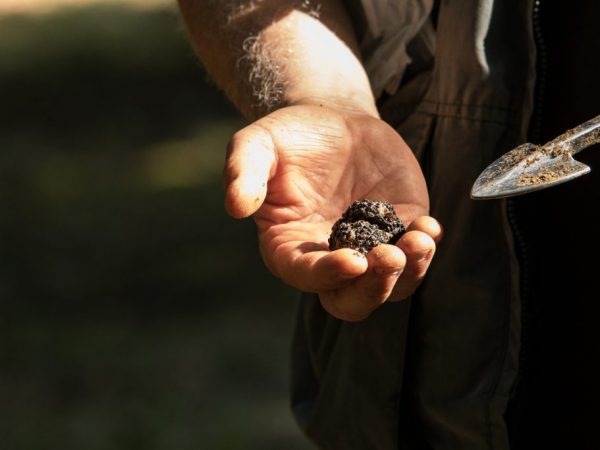
Truffles are long and expensive to grow
Growing truffles at home is a profitable business, but it requires a lot of investment and the appropriate level of patience. Harvests begin to be obtained only 5-10 years after the laying of the grove. For the first time, cultivation began in France in the first half of the 19th century. By the end of the century, thousands of hectares were planted in this country with oak groves with truffles. France annually supplied about 1000 tons of mushrooms to world markets.
During the First World War, most of the forests were destroyed, because. there were intense battles in those places. The poor environmental situation also seriously affects the yield. Now in France, only 50 tons of truffles are grown per year.
Australian, Chinese, Japanese, American farmers have learned to cultivate this tasty and original mushroom.
However, one should not expect that artificial cultivation of truffles will be the main source of income for the owner of the grove. Productivity is unstable, the first fruiting bodies have to wait about 5 years, the main production is obtained between 10 and 20 years of cultivation. Then, its amount gradually begins to fall.
Growing technology
Australian cultivation technology is considered the most productive. A year after planting, the first fruits are harvested, and after 5 years up to 20 kg of products per hectare are obtained. Primary requirements:
- The climate should be moderate and humid.
- The pH of the soil is 7.4-7.9.
- The roots of oak or hazel are suitable for infection with mycelium.
The soil is well dug up, it should contain useful minerals. The soil is fertilized 6-8 months before planting. All weeds are thoroughly removed (down to the last root). Herbicides and pest control products do not introduce: they will damage the mycelium.The only suitable formulation is ammonium glufosinate (non-selective contact herbicide).
To grow a truffle on its own, small sprouts of trees are infected with mycelium. First, they are quarantined for several weeks under sterile conditions. Immediately after applying the truffle mycelium, seedlings are planted in a nursery or greenhouse. They are transferred to open ground after a couple of months, when the height of the tree will reach at least 20 cm. A good time for planting is spring, when there is no threat of frost on the surface of the ground.
Planting depth - 75 cm. The area for one tree is 4 × 5 m. It is realistic to grow up to 500 seedlings per hectare. Around the tree, spread in a circle mulch from fallen leaves, forest litter (diameter - 40 cm). The main benefit of mulch is to create optimal conditions for the growth of mycelium. Attention! A truffle farm should not coexist with willows, poplars, chestnuts, and firs.
The truffle mushroom is capricious, so growing it takes patience. It is necessary to constantly check the composition and acidity of the soil, to prevent the appearance of weeds. The plantation is fenced so that small rodents and other animals do not get there. The most realistic is the cultivation of black truffles.
Conclusion
Truffles are the most expensive mushrooms in the world. They are capricious, so the annual harvest is small. Plus, they grow underground, making them difficult to find, which also affects the cost. It is possible to grow these mushrooms on your own, but waiting for the first harvest can take at least about 5 years.



